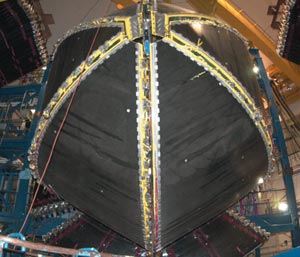Preliminary data on the hot topic of the search for pentaquarks were presented at the April Meeting of the American Physical Society by the Jefferson Laboratory’s CEBAF Large Acceptance Spectrometer (CLAS) collaboration. Quantum chromodynamics (QCD) does not forbid exotic, pentaquark states comprising four quarks and an antiquark, but the jury is still out as to whether such a state has been observed. Several experiments have published positive results while an equal number of different experiments have found nothing. The new result adds to the negative evidence.

The g11 experiment at the CLAS detector is a fixed-target photoproduction experiment in which a tagged photon beam, with photon energies individually measured, at an energy of 1.6-3.8 GeV hits a proton target. Data-taking was completed in 2004 with 70 pb-1 of integrated luminosity. The collaboration searched for the Θ+(1540) produced together with a neutral kaon in the reaction γp → Θ+Kbar0, where the Kbar0 is detected via its K0s component decaying into π+π–.
The Θ+ is expected to decay into a neutron and a K+, and the neutron is reconstructed from the missing mass in the reaction. No signal is seen in the nK+ mass spectrum, putting a limit on the production cross-section for γp → Θ+K0bar of less than 4 nb at a 95% confidence level.
This result is at odds with a published analysis of CLAS, where a Θ+ signal was seen with a 7.8 σ significance in the reaction γp → Θ+π+K–. The earlier study was performed on 5 pb-1 of data, where a couple of severe geometry cuts had to be applied to the original nK+ distribution to reveal the Θ+ signal. An experiment at higher energy to verify this result is planned.








